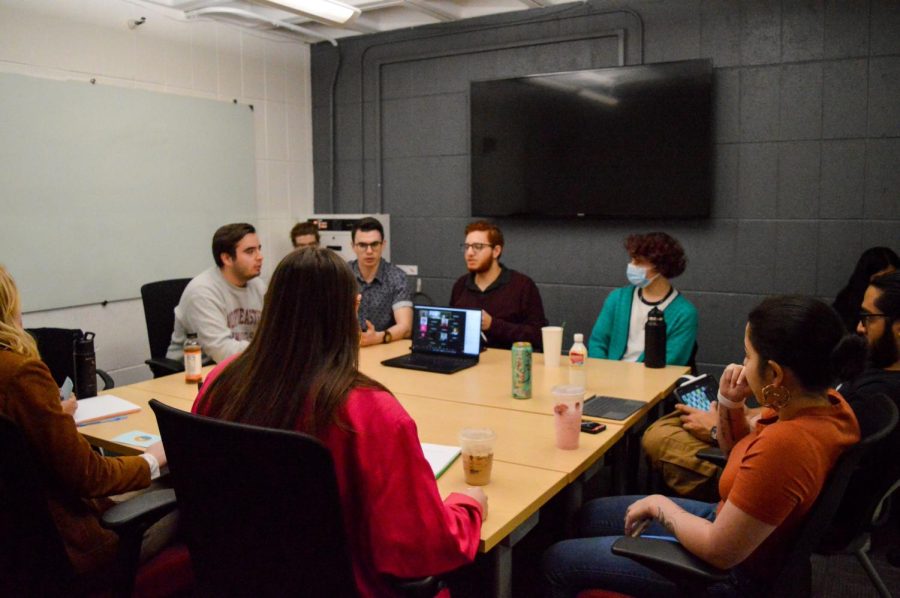SGA to hold contested election for first time in four years
At a debate Thursday, March 3, the two candidate slates were able to answer student questions about their platforms.
March 11, 2022
Two candidate slates are participating in the upcoming 2022 Student Government Association, or SGA, elections.
Third-year business administration major Rhea Tipnis is running for president with Abigail Sodergren, a second-year combined data science and business administration student, as executive vice president in the New Horizons campaign. They’re running against the Jorio-Chávez Ticket, with presidential candidate Angelica Jorio, a second-year political science and economics combined major, and executive vice president candidate Sebastian Chávez, the former vice president of student services and a third-year industrial engineering and political science double major.
Both presidential candidates expressed their passion for SGA and their excitement to run, in interviews with The News. Tipnis shared a personal story expressing just how long she’s been thinking about this position.
“One moment I remember was in our first ever senate meeting, I walked up to the chief of staff, and now president, Casey Buttke, and I asked her as a little freshman: ‘How can I be president?” Tipnis said. “I definitely think over these past few years, I’ve been able to answer that question for myself.”
This is the first time in four years that SGA will have a contested election. Rather than being intimidated by this, however, both presidential candidates have a positive outlook.
“I think more than competition, I see this as an extremely positive thing for our university,” Tipnis said. “When an election is contested, it truly gives students an opportunity to make a decision on which platform they think appeals to them more, who they think could be better student leaders, because we all have our stories, we all have our experiences.”
Jorio further emphasized that it’s necessary for SGA to have more than one candidate running in order to remove the image of SGA as a closed, “one-track” type of organization and allow for more diverse perspectives.
“I think one of the things I am most proud of is that it’s a contested space,” Jorio said. “I think it says a lot about an organization that this is the first time in four years that has ever happened.”
This was also one of the reasons Jorio is running for president, she said. She believes that many student groups on campus who want to accomplish some sort of significant advocacy face the challenge of simply not having the same access to resources as SGA, an issue she faced herself. As a member of the Interdisciplinary Women’s Collaborative, Jorio found that working with SGA was the only way the organization could achieve its goals.
“We realized that the only way we [Interdisciplinary Women’s Collaborative] were able to get something done on this campus was through SGA, unfortunately,” Jorio said.
She explained that while there are many good things that have come from the student government and the work its members do, there needs to be a closer relationship between the organization and the student body to more accurately reflect students’ needs.
“There’s such a disconnect there and in our way of thinking that SGA is the one place for doing advocacy on campus. And it’s not,” Jorio said. “There are 100 to 200 students in student government. We are a 20,000 student body strong.”
Tipnis also had thoughts on some improvements for SGA. She said the lack of awareness among students about SGA, as well as the organization’s disconnect with students, are the biggest issues within SGA and ones she hopes to fix.
“While the work that [SGA is] doing is great and we are constantly trying to get a better understanding of what our students care about, we obviously still have a lot of work to be done,” Tipnis said.
Additionally, she had similar opinions regarding the advocacy potential that students have and the importance of highlighting this potential in SGA.
“We truly think at Northeastern sometimes the power of youth leadership and of students goes unnoticed, and often it goes underutilized,” Tipnis said.
Looking forward, the candidates will be campaigning in the upcoming week before elections happening on March 14. This time will give them the opportunity to connect with the students and explain their goals and ideas for SGA and Northeastern. Both slates are eager for this campaigning period to begin, they said.
“I’m just excited to experience this journey,” Tipnis said. “The thrill of campaigning, the thrill of tabling, talking to students, all the ups and downs that we’re going to have; even being able to see the amazing ideas that the other slate is going to have.”
Chávez, who is running for executive vice president on the slate with Jorio, said he’s particularly excited for campaigning as he’s finally able to step outside the boundaries of his former roles in the student government and, instead, talk to the student body simply as a fellow student.
“I think in my role [as VP of Student Services], even though we expanded it a lot, I still felt somewhat constricted by the organization,” Chávez said. “I still feel very restricted by the organization but I think that this is kind of like, if anything, our time to shine.”
Current SGA President Casey Buttke also shared her excitement for the upcoming elections. She spoke positively about both candidates and looks forward to seeing their campaigns. When asked if she has any advice for the candidates, Buttke kept it simple.
“You want to be able to look back and know that you campaigned with full integrity,” Buttke said. “You want to see that you really showed who you were and what you wanted for the school and the association.”
Editor’s note: Angelica Jorio, one of the presidential candidates for this year’s SGA elections, is the former design editor for The News.







